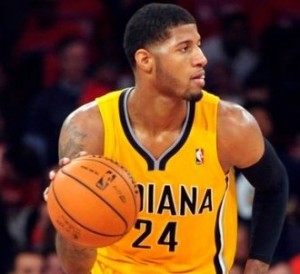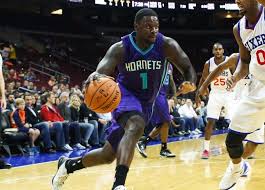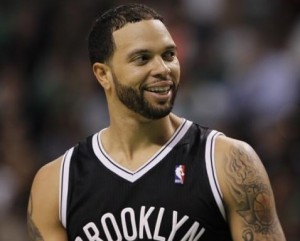Any time the University of Kentucky does anything (like they did Saturday night), two subjects come up: John Calipari and the NBA’s age restriction. The two are inextricably linked, and how you feel about one most likely influences how you feel about the other.
If you think that making players play a year in college before going pro is good because it means better players at the college level, and more polished players entering the NBA, you might love (or at least appreciate) Calipari for providing the best storyline in college hoops this year, with the Wildcats’ chase for an undefeated season. And if you think 18-year-olds shouldn’t be forced to play basketball for no pay, you might like this Albert Burneko piece for Deadspin (which is actually a response to a response by Slate’s AJ McCarthy to Burneko’s original piece, if you really want to dive in). Here’s an excerpt, and one that’s particularly pertinent to this NBA-centric basketball site:
Secondly, the notion that every instance of a star recruit making the NBA is an instance of a fair deal ignores how even those nominal successes can be screwed by their time in college (even apart from the fact that they don’t get paid for their work while there). Consider fellow Kentucky big man Nerlens Noel. Superficially, Noel might seem to buttress McCarthy’s point: He arrived at Kentucky as the top recruit in the nation, tore his ACL just weeks before the NCAA tournament in his freshman season, and still went on to a lucrative NBA contract as the sixth overall pick in the following draft. You may rightly assert that his Wildcat pedigree and Calipari’s imprimatur helped secure Noel’s draft position against concerns about his health, in service of a Coach Cal gets his guys paid! argument.
But then, account for the NBA’s rookie pay scale system, under the rubric of which draft position determines salary for all first-round picks. Prior to his ACL injury, Noel was the presumptive first overall pick in the 2013 draft (actually, “presumptive” may not be strong enough; that he would go first overall was a virtual certainty); when the draft finally rolled around he fell to sixth, thanks to concerns about his leg and how recovery might hamper his development. The first overall pick, Anthony Bennett, received a first-year salary of $4,436,900; Noel, at sixth, received $2,643,600—a difference of almost $1.8 million in their rookie season alone.
The first two seasons of an NBA rookie contract are guaranteed; the team has the option to pick up a third and fourth, plus the option to make a qualifying offer for a fifth season. All the year-to-year salary increases over the life of that contract are automated, and set according to draft position. Over the maximum five-season lifespan of his rookie deal, Noel’s draft position is worth around $11,000,000 less than if he’d gone first overall, as he would have if he hadn’t suffered the ACL injury. And unlike Alex Poythress, the Kentucky player who decided of his own free will to return to school and wound up with an expensive and prospect-darkening ACL injury of his own, Noel didn’t lose a dice roll of his own choosing. He played the single season of college ball essentially mandated by the NBA’s age restriction, got injured, and got f–ked.
Personally, I’d do away with the age restriction. If an 18-year-old is good enough to play in the NBA, let them get paid for their skills. I wouldn’t even be opposed to mandating two years in college for those who don’t go pro out of high school, similar to how MLB does. That would provide some continuity in the college game, let players develop, while also allowing the Anthony Davises and Nerlens Noels of the world to go pro right out of high school.
But it doesn’t look like that’s happening in the near future, so we’ll all just have to keep waiting an extra year to see the likes of Jahlil Okafor and Karl-Anthony Towns in the NBA.
Now, let’s get to some more of the latest news from around the basketball world:
PAUL GEORGE RETURNS SUNDAY
 The world needs the Paul George who was one of the NBA’s most fearsome two-way wings, not the one whose leg snapped in two during a live-televised scrimmage. The first step to getting that gruesome image out of our minds is by getting a new image of Paul George to replace it with. Here’s hoping he can give us that.
The world needs the Paul George who was one of the NBA’s most fearsome two-way wings, not the one whose leg snapped in two during a live-televised scrimmage. The first step to getting that gruesome image out of our minds is by getting a new image of Paul George to replace it with. Here’s hoping he can give us that.
A little more than eight months after breaking his right leg during a Team USA scrimmage in Las Vegas, George will make his season debut Sunday night against Miami. Coach Frank Vogel said George will play about 10 to 15 minutes, likely in the first and third quarters.
“It’s almost like being drafted again and getting thrown back out there again for the first time. It’s that same feel,” said George, who will be wearing his new No. 13 for the first time.
Larry Bird, the president of basketball operations for the Pacers, said Saturday that George had been cleared for game action a while ago, but was kept out because he was still working out with a limp. Before Friday night’s 93-74 victory over Charlotte, George started lobbying harder, but still couldn’t convince the top brass to let him play.
Indiana started Saturday in the No. 10 spot in the East, 1½ games behind Miami for the eighth and final playoff spot. After winning 13 of their first 15 games following Feb. 1, the Pacers have gone just 3-9 in the 12 games since.
But less than 24 hours after the victory over the Hornets jump-started the Pacers’ fading playoff hopes, Bird and other team officials decided to put their biggest star back on the court.
“He’s not going to run as smooth as he used to, but over time he’ll get better and better. Just in the last month I’ve seen a major difference,” Bird said. “Everybody thinks Paul George is coming back and that he’s 100 percent, but he’s not 100 percent and he’s in no condition to go out and play a 30-minute game.”
LANCE STEPHENSON: CAROLINA EXPERIENCE ‘HUMBLING’
 If you’re new to sports, “humbling” is athlete-speak for “terrible.”
If you’re new to sports, “humbling” is athlete-speak for “terrible.”
Candace Buckner of the Indianapolis Star:
Stephenson has not played in the last two games and Hornets coach Steve Clifford, who decided to sit Stephenson, has shared surprising candor when addressing his forsaken free agent of last summer.
“Lance is here because of me. I’m the one that wanted Lance,” Clifford said, according to the Charlotte Observer. “It’s simply that I can’t find a group that plays well when he’s out there.”
This season, Stephenson has averaged 8.3 points, 4.7 rebounds and 4.1 assists in 26.4 minutes per game – a drastic decline from his career-highs of 13.8 points, 7.2 rebounds and 4.6 assists in 35.3 minutes of action in his fourth and final season as a Pacer. Though the Hornets have surpassed 74 games on the schedule, Stephenson said that he’s still “trying to learn the offense and get adjusted.” However, Stephenson does believe that he had more liberty with the Pacers than he has been afforded in Charlotte.
“I feel like the Pacers’ system, I could play freely and I could be myself. Here, it’s like I got a little button on me, like, ‘Dang! Don’t do that,'” Stephenson said. “I’ve just got to be able to play free and play relaxed and play through mistakes.”
Though Stephenson never took the bait when he was asked twice directly if he had regrets in choosing Charlotte over Indiana, he did use the word “humbling” three times in describing his first year as a Hornet.
DERON WILLIAMS IS SORT OF DOING OKAY
 It’s real easy to blame D-Will for the Nets’ shortcomings since the move to Brooklyn. And really, a lot of the blame should fall on his shoulders. But sometimes, he still has nights where he turns it on again. And with the Nets winning the race to the top of the bottom of the East playoff picture, the much-maligned point guard has been seeing those nights more and more lately.
It’s real easy to blame D-Will for the Nets’ shortcomings since the move to Brooklyn. And really, a lot of the blame should fall on his shoulders. But sometimes, he still has nights where he turns it on again. And with the Nets winning the race to the top of the bottom of the East playoff picture, the much-maligned point guard has been seeing those nights more and more lately.
This time, Williams played the entire second half. Nets coach Lionel Hollins didn’t have confidence in his bench, he said, so he made his best decision of the 2014-15 campaign, riding his starters to victory. Jack, who came in ranked 76th among 80 qualifying point guards in Real Plus-Minus, was a minus-11 in 10 minutes. Normally, Hollins rides him down the stretch. Not this time. And Hollins was rewarded as a result. Williams was a plus-16 in 38 minutes.
Williams, Brook Lopez and trade-deadline steal Thaddeus Young combined for 90 points. Lopez, who also played the entire second half, had 30 points and 17 rebounds in 44 minutes, while Young added 29 points, six rebounds, four steals and what proved to be the game-winning shot — a putback of D-Will’s miss with 22 seconds left that unlocked a 109-all tie — in 37 minutes.
“Anytime you can get in this type of situation, it’s huge,” said Young, who was acquired in exchange for potential future Minnesota owner-to-be Kevin Garnett. “I’m one of those players that wants to be in the playoffs each and every year, and I want a chance to win championships. When they told me they were going to trade me here, I said, ‘Perfect.'”
Young has proved to the perfect fit for what has become a dominant starting lineup. The combination of Williams, Young, Lopez, Joe Johnson and rookie Markel Brown has outscored the opposition by 18.2 points per 100 possessions since the All-Star break — the third-best mark of any five-man lineup (min. 150 minutes), according to NBA.com’s stats.
SWAGGY P DONE FOR YEAR
 Don’t get me wrong, I like smart, fundamentally sound basketball where everyone works within a system to move the ball, find the open man, and bury the shot as much as the next guy. But I also love Nick Young, and Nick Young basketball. Because sometimes, what’s important is having fun, and I don’t think anybody has more fun being in the NBA than Swaggy P. So that’s why this is sad.
Don’t get me wrong, I like smart, fundamentally sound basketball where everyone works within a system to move the ball, find the open man, and bury the shot as much as the next guy. But I also love Nick Young, and Nick Young basketball. Because sometimes, what’s important is having fun, and I don’t think anybody has more fun being in the NBA than Swaggy P. So that’s why this is sad.
Nick Young will likely sit out for the rest of the season, head coach Byron Scott said at practice on Saturday. Young has missed the Lakers’ last 20 games due to a fractured left kneecap.
“I haven’t even even talked to (head athletic trainer) Gary (Vitti), to be honest with you,” Scott said. “My feeling really is that, with seven games left, he probably won’t play the rest of the season. Like I said, the last report that I did get on him — which was when we were on the road — was that he really wasn’t making much progress.”
Young has been out of L.A.’s rotation since suffering his injury against Boston on Feb. 22. Since then, he has been re-evaluated on a weekly basis.
“Being out as long as he’s been out with seven games to go, I don’t really see how he can probably play,” Scott said. “He’s got to get back into game condition and things like that. So I don’t think there’s a chance he’s going to play in the next week.”
